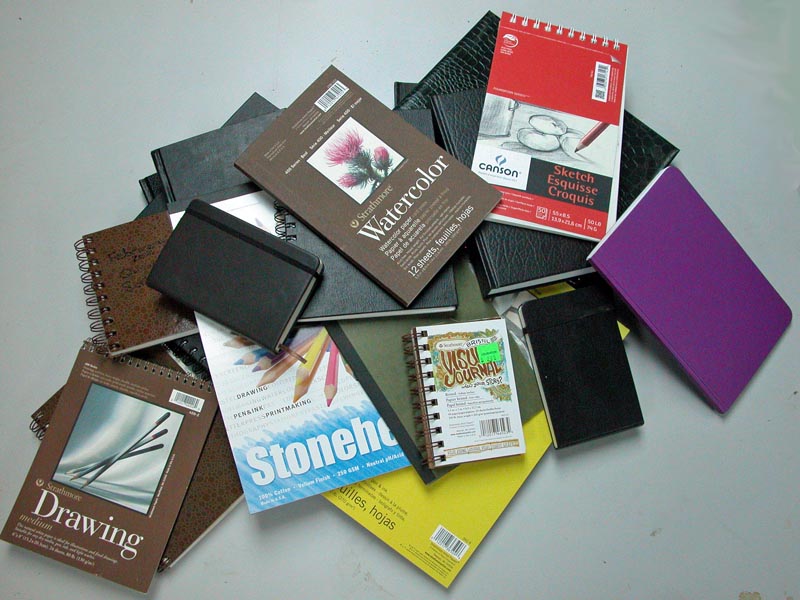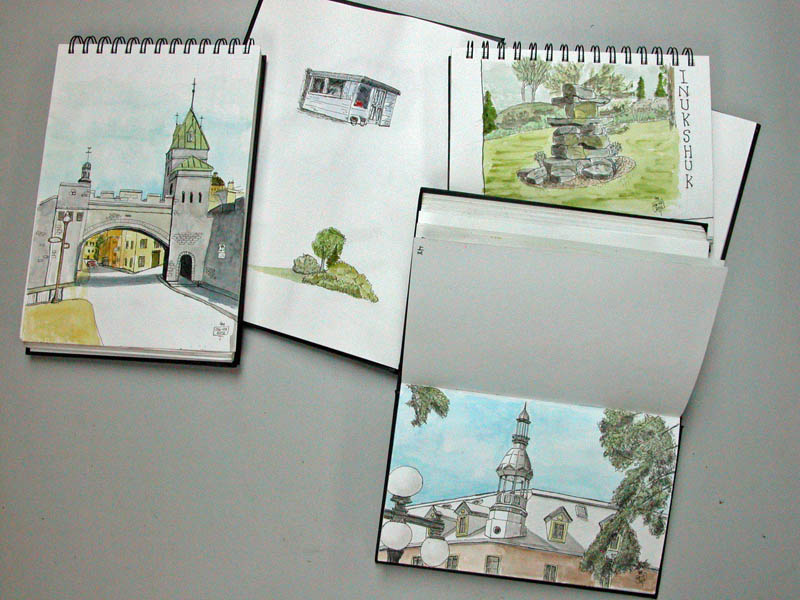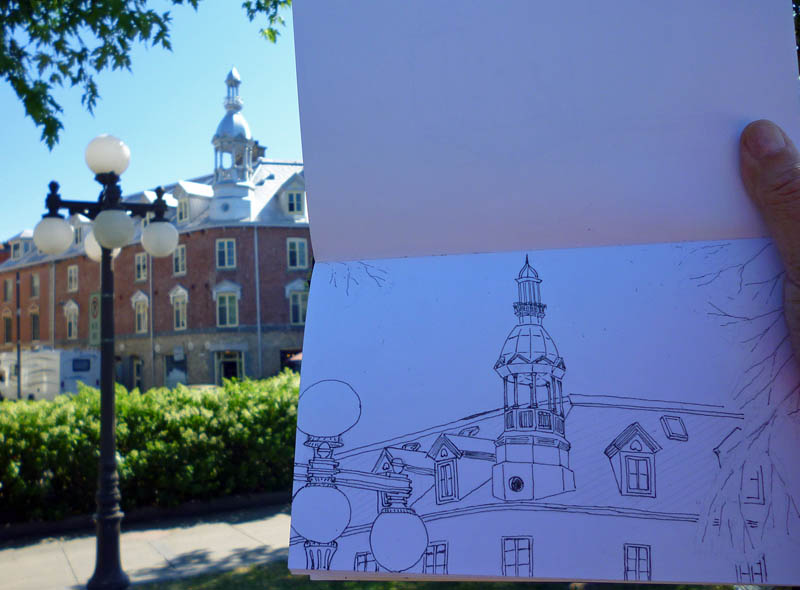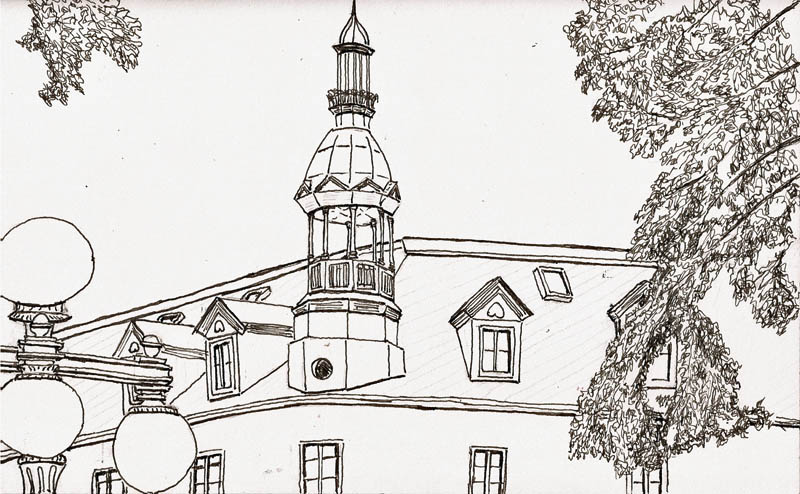I’m reluctant to endorse products as I feel that sketching is a personal thing with as many ways of doing it as there are people. But I sketch and I post my sketches in several places. I always list the materials used as I remember when I was getting started, and the frustration I felt when I was searching for information on the materials other people used.
Now that I’ve been sketching for ten months, I have people asking me about the Stillman & Birn sketchbooks and why I use them. I’m not alone, of course, as many sketchers are singing the praises of these sketchbooks but when I’m asked I try to provide a response. I’ve found myself doing that enough times that it was time for a blog post to show you, and tell you, why I love these sketchbooks so much.
My Perspective
Don’tcha hate it when someone says “use this – it’s great” only to find that they have no experience with any other product? And how can you evaluate someone else’s comments about a product without knowing how they work, what they expect of a product, etc. So I thought I’d start this by answering those questions.
I’ve mentioned that I’ve only been sketching for ten months. I’m a newbie. It’s said the Renoir, on his deathbed said, “It’s a pity; I was just figuring it out.” I understand those words as any creative form takes a long time to learn and I’m still in the beginning stages of learning to sketch. That said, I may have more experience than some with the various products on the market as I’ve always felt that beginners, more than experts need to use the best materials (for them) that money can buy. Experts can evaluate a material and adjust to it. We beginners have no idea whether our successes or failures are due to our lack of ability or the materials themselves. I’ve always felt that eliminating poor materials as a factor, I gain confidence that my efforts can lead somewhere.
 And so, when I started sketching I tried dozens of pens, bought artist-grade watercolors, and stocked up on erasers (grin). And I bought sketchbooks. Oh, did I buy sketchbooks. I found that finding a sketchbook that fit my needs was, by far, the most difficult task. Not only are they the most expensive component, once you’ve bought them you feel you should use them, even though they aren’t what you’re looking for. You could spend a lifetime using up purchased sketchbooks with the hope of eventually you’d buy one that would work the way you wanted. Not me…I just kept buying and trying. I have a LOT of sketchbooks with only a few sketches in them before I concluded that it wasn’t up to the task. Until I got my hands on a Stillman & Birn sketchbook. My search ended; my dream came true.
And so, when I started sketching I tried dozens of pens, bought artist-grade watercolors, and stocked up on erasers (grin). And I bought sketchbooks. Oh, did I buy sketchbooks. I found that finding a sketchbook that fit my needs was, by far, the most difficult task. Not only are they the most expensive component, once you’ve bought them you feel you should use them, even though they aren’t what you’re looking for. You could spend a lifetime using up purchased sketchbooks with the hope of eventually you’d buy one that would work the way you wanted. Not me…I just kept buying and trying. I have a LOT of sketchbooks with only a few sketches in them before I concluded that it wasn’t up to the task. Until I got my hands on a Stillman & Birn sketchbook. My search ended; my dream came true.
My requirements start with my passion for pen & ink. Specifically, I use fountain pens and I needed a paper that was relatively smooth (many cold-press papers are too lumpy for pen & ink) and a paper with enough sizing that the inks wouldn’t feather (fuzzy edges). I also like the idea of using watercolors in my sketches so I needed a paper that was heavy enough to let me wet out a sky area and then start dropping in a wash. And I wanted a paper that wouldn’t buckle under such a treatment. I wanted a paper that wouldn’t bleed through to the back side. And I wanted that paper in an easy-to-carry sketchbook; a sketchbook that could sit on a shelf once I’d filled it.
 These are my current sketchbooks and the ones upon which my comments are based. They aren’t an exhaustive representation of the Stillman & Birn line of sketchbooks but, aside from their ivory paper equivalents, they are a pretty good cross-section as it turns out.
These are my current sketchbooks and the ones upon which my comments are based. They aren’t an exhaustive representation of the Stillman & Birn line of sketchbooks but, aside from their ivory paper equivalents, they are a pretty good cross-section as it turns out.
A) is a 10×7 spiral-bound Alpha series book. I love it when I want something a bit larger than my 5.5×8.5, which is my carry-everywhere sketchbook.
B) is a 9×12 hardbound Epsilon series book. This sits, open, on my desk and I use it to try new techniques, when I have a few minutes to doodle, or whatever. Mostly it’s a compendium of failures on my part but I love to flip through it as it’s also full of memories, even after 10 months.
C) is a 5.5×8.5 hardbound Alpha series book and it’s my carry-everywhere sketchbook. This one is nearly full and will be replaced by another just like it, or maybe a Beta in this size.
D) is a 6×8 Beta series book. Stillman & Birn says this is “rough” paper and I completely ignored this series for that reason until one day someone said, “It’s not rough at all; I love the Beta paper.” So I asked S&B if they’d send me a sample of their Beta paper. To my surprise, they sent me an entire sketchbook and the paper is truly amazing, though I’ve only done a few sketches on it.
So there you have it…my perspective and a bit about my experience. I’m no expert, nor do I claim to be. But I have used a sketchbook or three…or dozen.
Stillman & Birn paper
I quickly learned that if you want to use wet media, you need heavy paper. You’ll hear people saying all the time, “use at least 140lb watercolor paper” and that’s not bad advice and that advice certainly fits most of my experience with sketchbooks.
BUT…great big ‘but’ here, my experience with Stillman & Birn suggests that’s not the whole story. I’m not a paper expert so I’m treading out onto a thin limb here but it seems that how the papers are sized (chemicals added to it) is just as important as paper thickness. What I ‘know’ is that Stillman & Birn papers are double-sized, meaning that sizing is added to the paper mixture and also added to the surface of the paper as it’s made.
I’ll leave the technical details to others and they’re not really that important except to say that Stillman & Birn’s 100lb papers (in the Alpha, Gamma, and Epsilon series) hold up to watercolor washes at least as well as most 140lb watercolor papers and far better than other 100lb papers/sketchbooks I’ve used. Let’s just call it ‘magic’ but what’s important is that it’s true.
Alpha Series paper
Many sketchers have reported being surprised by how the 100 lb paper responds. I know I was. I use the Alpha series 100 lb paper. There is simply NO buckling of the paper when applying a wash. I find that if I really wet the paper it will sort of ‘curl’ a bit along its long axis but not a hint of buckling. Once dry, however, even the curl goes away. There is no bleed-through at all, regardless of what you apply. I’m one who sketches on only one side of the page but I often make notes about the sketch on the backside of the preceding sketch. This is not a problem when viewing sketches. S&B’s Gamma series is the same as the Alpha only with ivory-colored paper.
Beta Series paper
I actually have the least amount of experience with this paper but I REALLY like it. This is thick stuff – 180 lb stock. There is slightly more tooth to the Beta paper than the Alpha but it’s still plenty smooth enough for my fountain pens and while I’ve compared ink lines using a magnifier, I can’t see any differences in feathering.
What I do see is that this ultra-thick paper is fantastic for someone wanting to slop water all over a sketch. While the Alpha series papers hold up well, the Beta-series papers remain dead flat no matter what you do to them. It’s likely that I’ll switch to this paper as I fill my Alphas. The one downside, of course, is that thick paper means fewer sheets per sketchbook. My Alpha has 124 pages; the Beta equivalent only 52 so it’s hard to decide which is the better way to go. The Delta series is the same 180 lb paper as the Beta only it’s ivory-colored.
*** And guess what? The postman just arrived and I’m now the proud owner of the NEW HARDBOUND version (5.5×8.5) version of this series. It’s rare to find paper this thick bound into a hardcover and, until now, even S&B only had it available in spiral-bound form. Not any more as you can get it in this size as well as large size hardbound form.
Epsilon Series paper
The Epsilon series is unique in that it comes in white only. Its finish is called a ‘plate finish’ and smoother – you might say very smooth surface. Certainly this is the one to choose if you’re doing pencil work. But, like the Alpha series, its 100 lb, double-sized paper, handles watercolor washes well. What the smoother plate surface does, however, is cause the watercolors to skate around on the surface longer, which can be good if you do a lot of wet-in-wet mixing or bad if, like me, you’re a newbie and not well-versed in chasing watercolor washes. Personally I prefer the Alpha and Beta series to this one but some swear by the Epsilon for their watercolor sketching.
Stillman & Birn Bindings
When I show people my 5.5×8.5 sketchbook they often say “I have one like this.” But they don’t. They typically have one of the less expensive, and less good, generic black sketchbooks. The black binding is a tradition, it seems but I wish my S&Bs weren’t black – weren’t like those lesser sketchbooks. It would simply be easier for people to understand the differences.
Whether spiral-bound or hardbound, S&B sketchbooks have very hard, thick covers. I like this as I’m unkind to my sketchbooks. They get banged around, find themselves laying on the ground, and I’ve even sat on them, though that was by accident.
The spiral-bound books have double-ring bindings that I haven’t managed to squish (a technical term) like I have some of the lesser products. It’s the hardbound sketchbooks, though, that are the true marvel. These sketchbooks are double-stitched and just like ‘double-sized’ I don’t know what that is but I know what it means. It means they won’t come apart and you can get them to lie flat, two virtues that most sketchers appreciate.

You must ‘break in’ an S&B sketchbook to get it to lie flat and if you’re used to lesser products, you’ll find it scary. As with any book, the road to getting it to lie flat is to open it, a few pages at a time, and bend it open, generally such that the covers are lying flat on a surface. With S&B sketchbooks, though, you can fold them well beyond fully opened without cracking the binding or breaking the stitching. It’s a marvel to see it done for the first time. But notice, in the photo above, how I’ve bent back my Alpha series sketchbook to take the photo. This is pretty extreme but the sketchbook is no worse the wear for it.
Sketchbook Costs
[climbing onto soapbox…gosh that’s hard on my knees] I know…I know…you’re just a beginner and don’t feel you should use good paper or good sketchbooks. I hope you’ll reconsider. Do the arithmetic. Buying first class sketchbooks rather than lesser versions costs what, maybe $5-8 more? Divide that by the 124 pages of an Alpha series sketchbook and what’dya get? At $8 that’s 6.5 CENTS more per page. And $8 is less than the price of a single movie ticket (2 1/2h of entertainment?) – less than three lattes. Yet those 124 pages will provide hours of enjoyment and the confidence that comes from using first-class materials.
My first hardbound sketchbook cost me $10. The street price of an S&B Alpha series of the same size is $15 or roughly $5 more. I made a few attempts at pen/ink/watercolor sketches in that first sketchbook, the paper was horrible. I gave up. I’ve nearly filled the S&B sketchbook this summer…100 hours or more of fun. Which one was cheaper? You decide.
I hope this answers those who ask why I like the S&B sketchbooks. I’m not affiliated with S&B except that I’m a devoted customer. If you try their sketchbooks, I suspect you will become one as well. You can find more information Stillman & Birn sketchbooks from their website at: http://www.stillmanandbirn.com/
Cheers — Larry
larry@larrydmarshall.com











